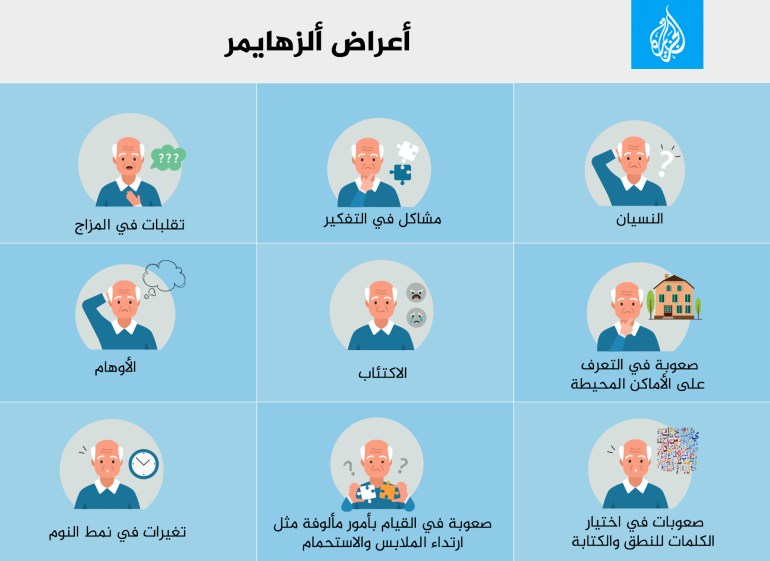A recent study found that a person's willingness to give money to an unknown person is associated with an increased risk of Alzheimer's disease, so how is that?
The answer is here, with comprehensive questions and answers about the disease.
Before we continue, we stress here that generosity is one of the noble human qualities, and it is one of the components of Arab and Islamic culture.
But what the study looks for is a relationship between giving money to an unknown recipient and the risk of Alzheimer's.
The study was conducted by researchers from the Keck School of Medicine at the University of Southern California, and was published in the Journal of Alzheimer's Disease.
The study found that older adults' willingness to give money correlates with cognitive indicators in the early stages of Alzheimer's disease.
Financial abuse and Alzheimer's disease
Researchers are trying to identify those most vulnerable to financial exploitation, in order to help protect the elderly.
Recent research from the Keck School of Medicine suggests a link between financial generosity - with the unworthy and out of place - and the early stages of Alzheimer's disease.
The researchers asked 67 older adults without dementia or cognitive impairment to choose between donating the money to an anonymous recipient and keeping it for themselves.
Additionally, they took part in several cognitive tests, including word and story recall.
On cognitive tests known to be sensitive to Alzheimer's disease, those who gave more money performed worse.
"Our goal is to understand why some older adults are more vulnerable than others to fraud, defraud or financial exploitation," said study senior author Dr. Doc Hahn.
"It is believed that trouble handling money is one of the early signs of Alzheimer's disease, and this finding supports that idea."
What is the cause of Alzheimer's disease?
Alzheimer's disease is thought to be caused by an abnormal buildup of proteins in and around brain cells, according to the British National Health Service (NHS).
One of the proteins involved is called amyloid, whose deposits form plaques around brain cells.
The other protein is called tau, and its deposits form tangles inside brain cells.
Although it is not known exactly why this process begins, scientists now know that it begins many years before symptoms appear.
Can Alzheimer's disease be cured?
There is currently no cure for Alzheimer's disease.
But there is a treatment that can temporarily reduce symptoms, according to the British National Health Service.
Support is also available to help a person with this condition and their family cope with daily life.
How does Alzheimer's disease start?
Alzheimer's disease begins as:
Changes in the brain begin a decade or more before symptoms begin.
Abnormal clumps of a protein called beta-amyloid and tau fibers start in the brain.
With these abnormal accumulations, the functions of neurons in the brain decline.
Over time, cells lose their ability to connect and function.
Eventually the cells die.
As the dead cells increase, a person's brain shrinks.
Alzheimer's disease diagnosis
According to the Mayo Clinic website, to diagnose Alzheimer's dementia, doctors perform tests to assess impaired memory and other thinking skills, judge functional abilities, and identify behavioral changes.
They also perform a series of tests to rule out other possible causes of weakness.
Alzheimer's patient behavior
According to Susanna Saxel, a member of the German Alzheimer's Association, Alzheimer's disease can be inferred by observing some signs, such as memory, language and spatial orientation disorders, in addition to personality changes.
One of the symptoms that indicates this is forgetting names and addresses and doing some strange behavior such as putting a wallet in the refrigerator, for example.
Alzheimer's patients are usually distracted and irritable, and quickly feel overburdened or under attack.
The patient also becomes aggressive due to external stimuli such as loud sounds, and in situations that cause him to feel anxious and afraid.
The aggressive behavior of the patient can be avoided by providing a calm and friendly environment.
If these symptoms are observed, the relatives should immediately present the patient to a neurologist for timely treatment.
The lifespan of an Alzheimer's patient
On average, a person with Alzheimer's lives 4 to 8 years after diagnosis, but can live up to 20 years, depending on other factors.
Changes in the brain related to Alzheimer's disease begin years before any signs of the disease appear, according to the Alzheimer's Association.
How does Alzheimer's patient feel?
Alzheimer's patients may experience memory loss, difficulty thinking or concentrating, irritability, mood swings, tantrums, and other changes associated with changes in the brain.
Alzheimer's types
There are two types of Alzheimer's disease, according to the American National Institute on Aging.
Early-Onset Alzheimer's
The signs first appear between the 1930s and the mid-1960s
very rare
It may contain a gene called "APOE ɛ4).
Late-Onset Alzheimer's
The signs first appear in a person's mid-sixties
The most common type
It is usually caused by genetic changes passed from parent to child
Is Alzheimer's disease fatal?
According to the US Centers for Disease Control and Prevention (CDC), Alzheimer's disease is a fatal form of dementia.
It is the sixth leading cause of death in the United States, accounting for 3.6% of all deaths in 2014. It is the fifth leading cause of death for people aged 65 or older in the United States.
Alzheimer's disease name
The disease took its name from German Dr. Alois Alzheimer, who described the disease in 1906, after he noticed anatomical changes in the brain of a woman who had died of unusual mental illness, and symptoms included memory loss and speech problems.
World Alzheimer's Day
On September 21 of each year, the world celebrates the World Alzheimer's Day, and it aims to raise awareness of the disease and seek to mitigate its social effects.

